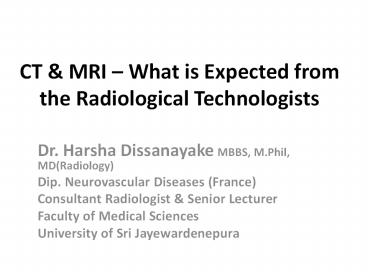CT - PowerPoint PPT Presentation
1 / 21
Title: CT
1
CT MRI What is Expected from the Radiological
Technologists
- Dr. Harsha Dissanayake MBBS, M.Phil,
MD(Radiology) - Dip. Neurovascular Diseases (France)
- Consultant Radiologist Senior Lecturer
- Faculty of Medical Sciences
- University of Sri Jayewardenepura
2
Radiographer Radiological TechnologistMedical
Imaging Technologist
3
Who is a Radiological Technologist?
- a trained health care professional
- who performs medical imaging by
- producing high quality images which is useful to
diagnose and treat injury or disease. - patients diagnosis and treatment is often
dependent on the images produced. - He is an important member of the Health care team.
4
Health Care Professional
- undertakes a specialized set of tasks
- enjoys considerable work autonomy
- engaged in creative and intellectually
challenging work - Patients place a great deal of trust in them
- strict codes of conduct
- Ethical and moral obligations
5
What should be the goal when encountered with a
patient
- To generate the best possible,
- Highest quality,
- Appropriate images
- which will be used to arrive at the diagnosis /
or to treat.
6
How to achieve this goal ?
- Asses the patients problem get the information
- Analyze
- Set the goal clear
- Formulate a plan to achieve the goal
- Workout the plan performing the tasks
- Self evaluate your images Is this the best
possible images that I can generate?
7
Quality control of the procedure
- Inferior quality images / study
- Area of interest inadequately covered / all
sequences not included .etc - May lead to
- Inaccurate interpretation / wrong diagnosis
- Repeated exposure
- Radiation hazards to the patient / self / staff
- Additional cost
- Additional time
8
Competency ?
- expertise and knowledge of patient handling
- physics, anatomy, physiology and radiology to
assess patients - develop optimal radiologic techniques to plan and
evaluate resulting radiographic images. - Should be able to spot what is not normal
pathology - Radiation Protection
- Quality Control
9
How the competency is gained?
- High school Diploma Certificate course
- University Degree BSc in Diagnostic
Radiography/Diagnostic Imaging 3yrs - Can specialize in-house or through a university
course as a postgraduate in CT, MRI, Nuclear
Medicine .. with opportunities to gain an MSc in
their field.
10
CT MRI What is Expected from the Radiological
Technologists
- Before / During / After the procedure
- Check the identity and the requested
investigation - Check the consent
- explaining the procedure
- ensure that the patent has had the correct
preparation - Keep the emergency tray ready
11
- clothing, ensure that there are no metal objects
that may interfere - Check the clinical details if inadequate make a
note of the patents problem relevant details.
Get previous imaging Ix reports/films - If the requested investigation is not clear /
inappropriate, always discuss with the referring
clinician - Check the patients data sheet / questionnaire
whether it is appropriately filled - Are there any contraindications / Allergies?
12
During the scanning
- Radiation dose
- All medical radiation exposures must be justified
and the radiation levels optimized - Radiation to the patient (in diagnostic studies),
staff and the general public are to be kept As
Low As Reasonably Achievable (the ALARA
principle)
13
Protocols
- Protocols are mere guidelines.
- Has to modify according to the individual
patients problem when ever necessary - Timing of the procedure
- Whether to give contrast or not
- Timing of the contrast injection
- Arterial / venous / late phases
- Oral /rectal contrast
- MRI additional sequences - ? Haemorrage /
Calcification / stroke ..
14
Example 1
- 60yrs
- Male
- Haematuria
- Ix. CT KUB
15
CT KUB Normal / no calculi
16
- Are you happy?
17
Late finding
18
48 yrs / liver lesion in USS Ix. - Triple
phase CT
- Arterial
- Portal venous
19
Ix. - Triple phase CT
- Arterial
- Portal venous
20
Ix. - Triple phase CT
- Arterial
- Portal venous
21
(No Transcript)































